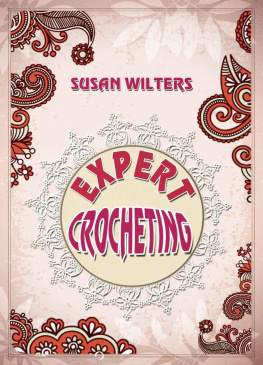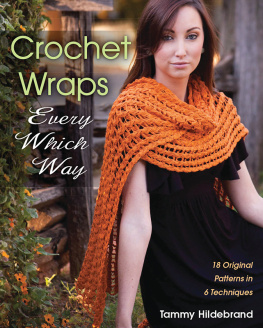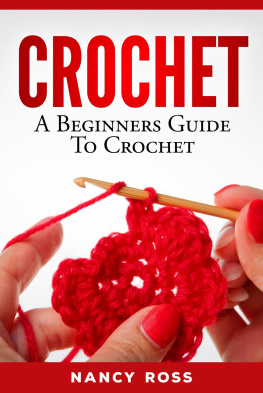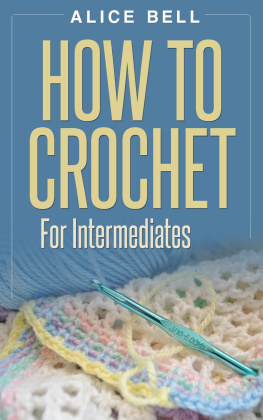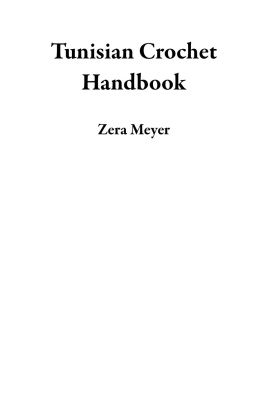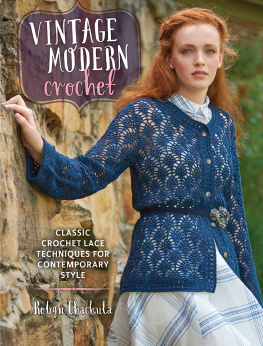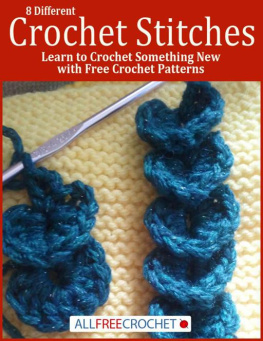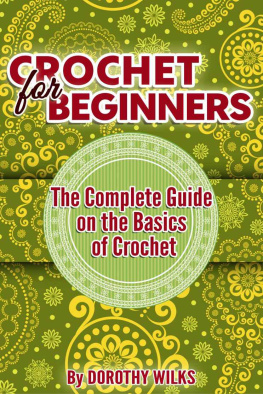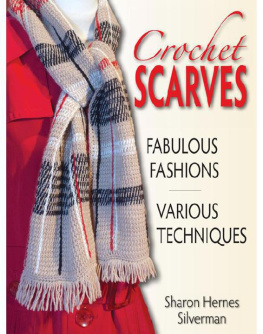Susan Wilters - Expert Crocheting
Here you can read online Susan Wilters - Expert Crocheting full text of the book (entire story) in english for free. Download pdf and epub, get meaning, cover and reviews about this ebook. year: 2015, genre: Home and family. Description of the work, (preface) as well as reviews are available. Best literature library LitArk.com created for fans of good reading and offers a wide selection of genres:
Romance novel
Science fiction
Adventure
Detective
Science
History
Home and family
Prose
Art
Politics
Computer
Non-fiction
Religion
Business
Children
Humor
Choose a favorite category and find really read worthwhile books. Enjoy immersion in the world of imagination, feel the emotions of the characters or learn something new for yourself, make an fascinating discovery.
- Book:Expert Crocheting
- Author:
- Genre:
- Year:2015
- Rating:3 / 5
- Favourites:Add to favourites
- Your mark:
- 60
- 1
- 2
- 3
- 4
- 5
Expert Crocheting: summary, description and annotation
We offer to read an annotation, description, summary or preface (depends on what the author of the book "Expert Crocheting" wrote himself). If you haven't found the necessary information about the book — write in the comments, we will try to find it.
Expert Crocheting — read online for free the complete book (whole text) full work
Below is the text of the book, divided by pages. System saving the place of the last page read, allows you to conveniently read the book "Expert Crocheting" online for free, without having to search again every time where you left off. Put a bookmark, and you can go to the page where you finished reading at any time.
Font size:
Interval:
Bookmark:
Contents
Thank you for purchasing the third and final book in mycrochet series. This book is geared toward the advanced or intermediatecrocheter who wants to take their skills to the expert level. In this book wewill learn all about graphs and charts, how to crochet the Intarsia method, andexplore more expert techniques. I love to crochet and Ive been doing it sinceI was a young girl. Im blessed to come from a long line of creative women andI have passed this down to my daughter in hopes she will continue thetradition. One of the things I really like about crochet is the opportunity itgives me to express my creativity and create beautiful and useful items formyself, family, and friends. If you love crochet as much as I do and want tolearn expert techniques then youve made the right choice with this book. Soare you ready to get started? I am so lets get to it!
ChapterOne Crochet Charts
Many expert level patterns use charts instead of writing outthe entire pattern. This is because the written pattern would be many pageslong and quite confusing. Learning how to read a chart is very beneficial inadvancing your crochet skills. A chart may be a bit intimidating at first andwhen you see all of the symbols grouped together you may want to just give upbefore you even try. But take heart, like all things if you take it bit by bitand slowly you can learn how to read even the most complex crochet chart. Thistable which can be found on the Craft Yarn Councilcovers most of the symbols used in crochet charts. You should always check thekey for the chart youre going to work first to understand the symbols used bythe designer. But this table includes the standard symbol used in most crochetcharts.

Now lets take a look at a simple chart design. This is a heartdesign from DMC USA website. This pattern uses four basic stitches; chainstitch, half double crochet, single crochet, and slip stitch. The pattern isread from left to right for the odd rows, and right to left for the even rows. Referto the chart above and you can see how the stitches for the pattern.

Start at the black triangle and chain three for thefoundation row. The first row consists of one half double crochet into each ofthe foundation chains chain stitches. The second row is two half doublecrochet into each of the half double crochet of the previous row. For the thirdrow you start with two half double crochet into the first stitch of theprevious row, one half double crochet between the first and second stitch andone half double crochet into each stitch to the last two stitches. Then youwork a half double crochet between the next to the last and last stitch, andtwo half double crochet into the last stitch.
Continue to work the chart until you complete the heart. Atthis point slip stitch three times to get to the correct place. Chain seven andwork a single crochet into the chain two of the correct row. Chain seven andsingle crochet into the stitches denoted on the chart all of the way around theheart and join with a slip stitch into the first chain stitch. The last row isworked with five half double crochet into the third chain all of the way aroundthe heart and join in the first chain stitch and break the yarn. The whitetriangle is the point at which you would break your yarn.

In this example of a Granny Square from Crafty Minx you cansee that you start in the middle of the chart with a chain four joined by aslip stitch. Next chain three and work two double crochet, chain one, and threedouble crochet all of the way around this round. The second round is joined ina corner with a slip stitch and chain three. Two double crochet, chain two, andthree double crochet are worked I n the corner. You then chain one between eachthree double crochet grouping. The second color is ended and the third color isjoined in a corner and the pattern is continued until you have completed thethird round.

In this example from The Best Knitters Guide you can seehow the designer has drawn the chart to closely resemble the final square. Hereis the square worked up from this chart.

When working charts just take it one row or stitch group ata time. Notice where the stitches are worked in relationship to the previousrow and always count the stitches on the chart and in your work. Charts can beworked in rows or in the round. Some charts have arrows showing you which way towork, but most dont. Likewise some charts have color changes, but most chartslet you decide the color scheme.
Charts are a great way to work patterns that would be manypages if written out, and they can be worked no matter what language you readand write in. So if you find a pretty chart from a site that is not in yournative language youll still be able to work up the pattern since you know howto read a chart.
You can find lots of charts for free online. Pinterest is agood resource for charts and free pattern links. You may even want to try yourhand at creating your work chart once you get the hang of them.
ChapterTwo Crochet Graphs Color Work Techniques
Graphs are used in Intarsia crochet and other color workpatterns. Graphs are very similar to charts, but unlike charts which may usemany different stitches most graph patterns are worked in one stitch, usuallysingle crochet or half double crochet. This is because the graph pattern needsto be consistent for the picture to show up correctly.
Intarsia Color Works and Graphs
A graph is read from left to right and then right to left.In other words the odd rows are read from right to left, and even rows are readfrom left to right. In this example from Crochet Kitten you can see that youfirst need a foundation chain of 15 plus one for the first single crochet.Starting at the right lower left corner the first row is 15 single crochet inwhite. Row 2 starts on the left side and chain one and 6 white single crochet,then 1 red single crochet, and then 7 white single crochet to complete the row.Row 3 is read from right to left and consists of chain 1 and 5 white singlecrochet, 3 red single crochet, and then 6 white single crochet. Continue up thegraph in this manner until you have completed the pattern.

Here is an example of heart washcloth which is very similarto the heart graph.

When working an Intarsia graph pattern wind up yarn onbobbins to make it easier to handle. Since you will be changing colors often ina row you dont want to have to be wrestling large balls or skeins of yarnwhile you work. As you work across a row and it is time to change colors workthe last stitch of the old color until you have two loops on the hook, drop theold color and pick up the new one and pull it through the two loops catchingthe old color under the new one. This helps lock the colors in place. Dont cutthe yarn, just leave the old color resting there until you work back across therow and need it again.
Font size:
Interval:
Bookmark:
Similar books «Expert Crocheting»
Look at similar books to Expert Crocheting. We have selected literature similar in name and meaning in the hope of providing readers with more options to find new, interesting, not yet read works.
Discussion, reviews of the book Expert Crocheting and just readers' own opinions. Leave your comments, write what you think about the work, its meaning or the main characters. Specify what exactly you liked and what you didn't like, and why you think so.

